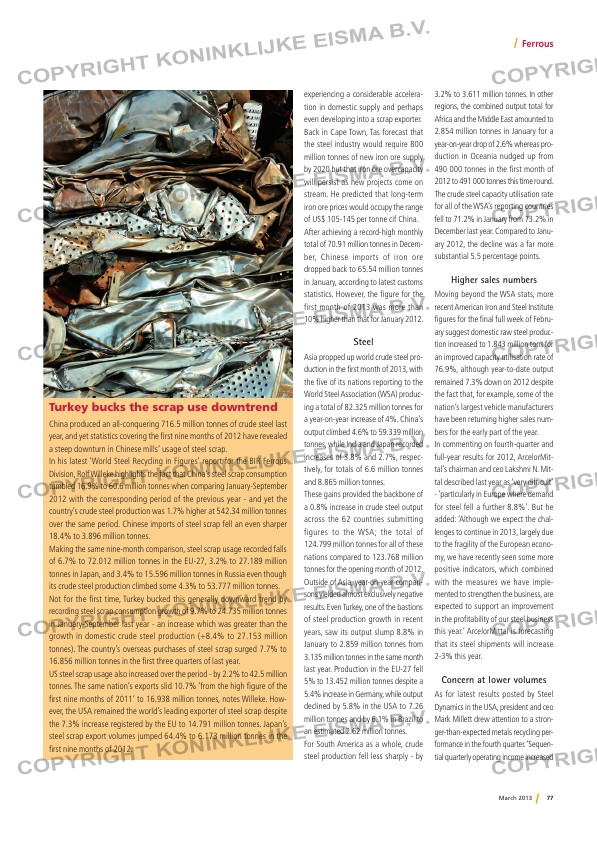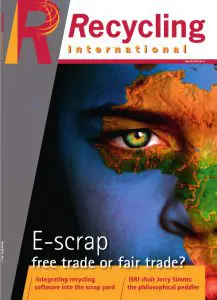Page 77 from: March 2013

77March 2013
Ferrous
experiencing a considerable accelera-
tion in domestic supply and perhaps
even developing into a scrap exporter.
Back in Cape Town, Tas forecast that
the steel industry would require 800
million tonnes of new iron ore supply
by 2020 but that iron ore overcapacity
will persist as new projects come on
stream. He predicted that long-term
iron ore prices would occupy the range
of US$ 105-145 per tonne cif China.
After achieving a record-high monthly
total of 70.91 million tonnes in Decem-
ber, Chinese imports of iron ore
dropped back to 65.54 million tonnes
in January, according to latest customs
statistics. However, the figure for the
first month of 2013 was more than
10% higher than that for January 2012.
Steel
Asia propped up world crude steel pro-
duction in the first month of 2013, with
the five of its nations reporting to the
World Steel Association (WSA) produc-
ing a total of 82.325 million tonnes for
a year-on-year increase of 4%. China’s
output climbed 4.6% to 59.339 million
tonnes, while India and Japan recorded
increases of 3.8% and 2.7%, respec-
tively, for totals of 6.6 million tonnes
and 8.865 million tonnes.
These gains provided the backbone of
a 0.8% increase in crude steel output
across the 62 countries submitting
figures to the WSA; the total of
124.799 million tonnes for all of these
nations compared to 123.768 million
tonnes for the opening month of 2012.
Outside of Asia, year-on-year compari-
sons yielded almost exclusively negative
results. Even Turkey, one of the bastions
of steel production growth in recent
years, saw its output slump 8.8% in
January to 2.859 million tonnes from
3.135 million tonnes in the same month
last year. Production in the EU-27 fell
5% to 13.452 million tonnes despite a
5.4% increase in Germany, while output
declined by 5.8% in the USA to 7.26
million tonnes and by 6.1% in Brazil to
an estimated 2.62 million tonnes.
For South America as a whole, crude
steel production fell less sharply – by
3.2% to 3.611 million tonnes. In other
regions, the combined output total for
Africa and the Middle East amounted to
2.854 million tonnes in January for a
year-on-year drop of 2.6% whereas pro-
duction in Oceania nudged up from
490 000 tonnes in the first month of
2012 to 491 000 tonnes this time round.
The crude steel capacity utilisation rate
for all of the WSA’s reporting countries
fell to 71.2% in January from 73.2% in
December last year. Compared to Janu-
ary 2012, the decline was a far more
substantial 5.5 percentage points.
Higher sales numbers
Moving beyond the WSA stats, more
recent American Iron and Steel Institute
figures for the final full week of Febru-
ary suggest domestic raw steel produc-
tion increased to 1.843 million tons for
an improved capacity utilisation rate of
76.9%, although year-to-date output
remained 7.3% down on 2012 despite
the fact that, for example, some of the
nation’s largest vehicle manufacturers
have been returning higher sales num-
bers for the early part of the year.
In commenting on fourth-quarter and
full-year results for 2012, ArcelorMit-
tal’s chairman and ceo Lakshmi N. Mit-
tal described last year as ‘very difficult’
– ‘particularly in Europe where demand
for steel fell a further 8.8%’. But he
added: ‘Although we expect the chal-
lenges to continue in 2013, largely due
to the fragility of the European econo-
my, we have recently seen some more
positive indicators, which combined
with the measures we have imple-
mented to strengthen the business, are
expected to support an improvement
in the profitability of our steel business
this year.’ ArcelorMittal is forecasting
that its steel shipments will increase
2-3% this year.
Concern at lower volumes
As for latest results posted by Steel
Dynamics in the USA, president and ceo
Mark Millett drew attention to a stron-
ger-than-expected metals recycling per-
formance in the fourth quarter. ‘Sequen-
tial quarterly operating income increased
Turkey bucks the scrap use downtrend
China produced an all-conquering 716.5 million tonnes of crude steel last
year, and yet statistics covering the first nine months of 2012 have revealed
a steep downturn in Chinese mills’ usage of steel scrap.
In his latest ‘World Steel Recycling in Figures’ report for the BIR Ferrous
Division, Rolf Willeke highlights the fact that China’s steel scrap consumption
tumbled 16.9% to 60.6 million tonnes when comparing January-September
2012 with the corresponding period of the previous year – and yet the
country’s crude steel production was 1.7% higher at 542.34 million tonnes
over the same period. Chinese imports of steel scrap fell an even sharper
18.4% to 3.896 million tonnes.
Making the same nine-month comparison, steel scrap usage recorded falls
of 6.7% to 72.012 million tonnes in the EU-27, 3.2% to 27.189 million
tonnes in Japan, and 3.4% to 15.596 million tonnes in Russia even though
its crude steel production climbed some 4.3% to 53.777 million tonnes.
Not for the first time, Turkey bucked this generally downward trend by
recording steel scrap consumption growth of 9.7% to 24.735 million tonnes
in January-September last year – an increase which was greater than the
growth in domestic crude steel production (+8.4% to 27.153 million
tonnes). The country’s overseas purchases of steel scrap surged 7.7% to
16.856 million tonnes in the first three quarters of last year.
US steel scrap usage also increased over the period – by 2.2% to 42.5 million
tonnes. The same nation’s exports slid 10.7% ‘from the high figure of the
first nine months of 2011’ to 16.938 million tonnes, notes Willeke. How-
ever, the USA remained the world’s leading exporter of steel scrap despite
the 7.3% increase registered by the EU to 14.791 million tonnes. Japan’s
steel scrap export volumes jumped 64.4% to 6.173 million tonnes in the
first nine months of 2012.
RI_2-MA-Ferrous.indd 77 06-03-13 09:30



